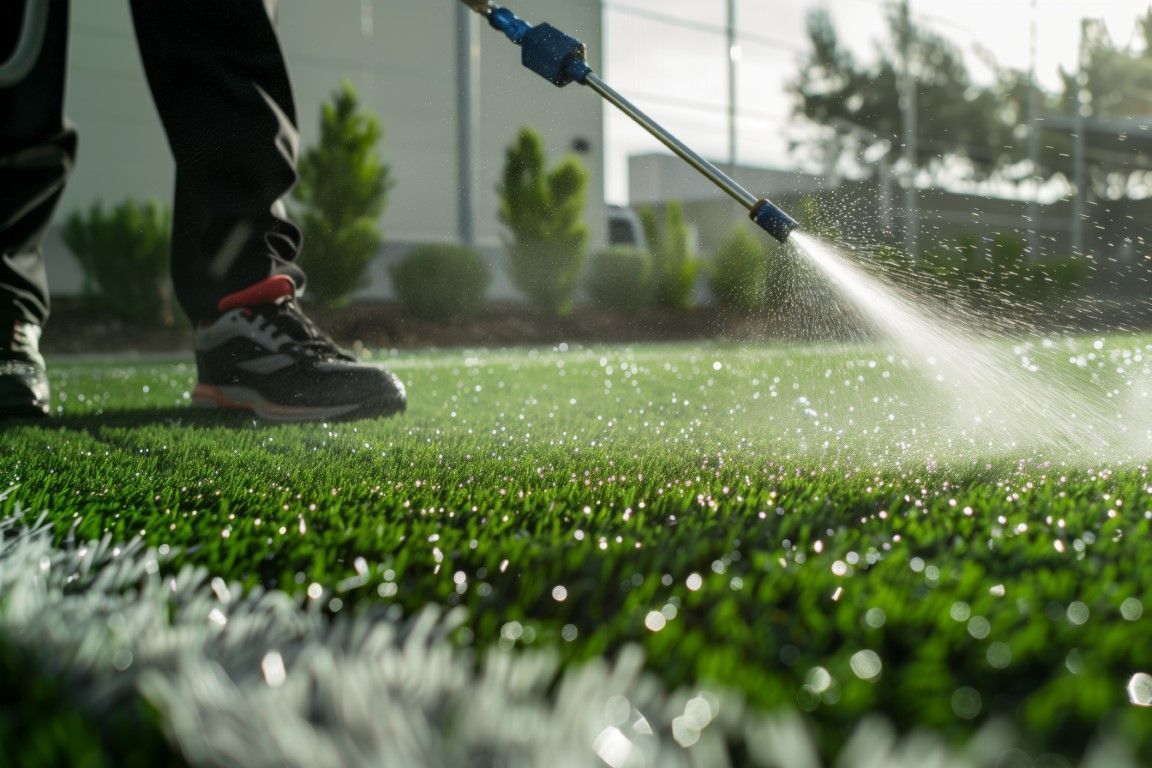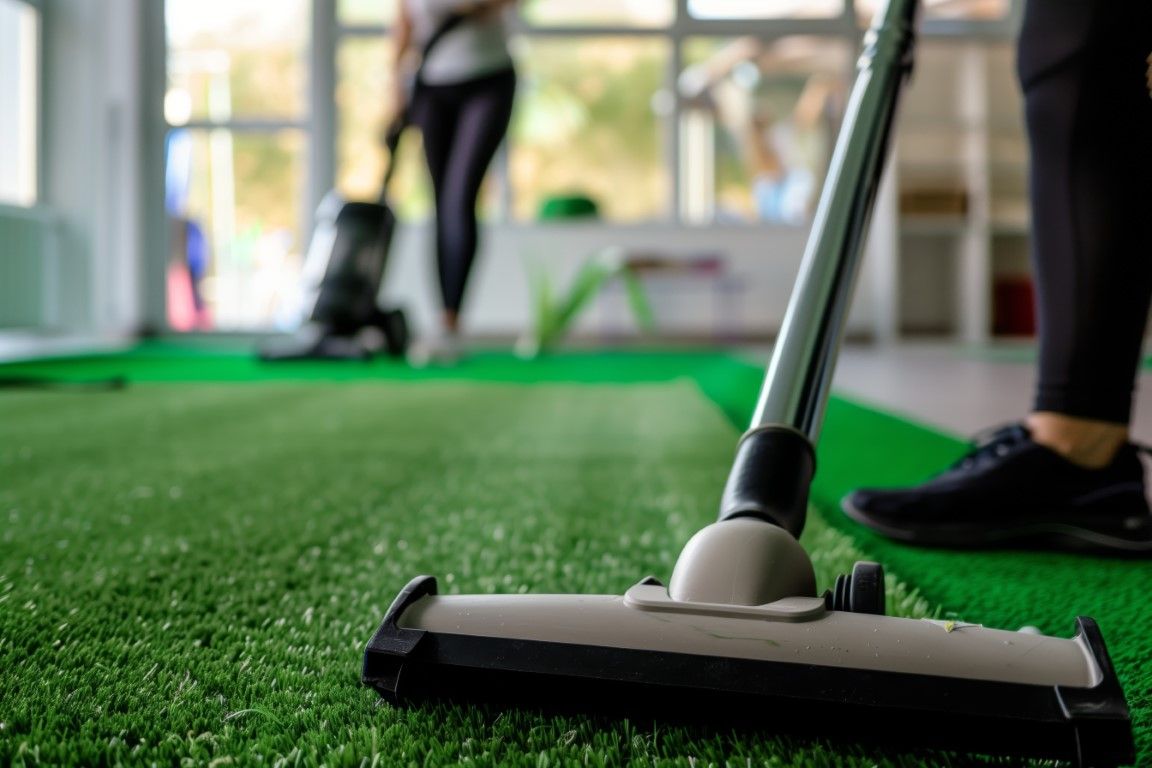Emerald Artificial Grass
(850) 308-2111
Artificial Grass Maintenance and Cleaning in Pensacola FL
Artificial grass offers the advantage of reduced maintenance compared to natural grass, but it still needs regular attention to ensure it stays in pristine condition. Over time, dirt, dust, debris, and even stains can accumulate, causing the turf to lose its vibrancy. Without proper care, the material can wear out faster, leading to a dull, worn-out look. Regular cleaning helps prevent damage from the elements, pets, and other external factors, ensuring your investment remains visually appealing and functional.
Types of Artificial Grass
Understanding the types of artificial grass is crucial for proper maintenance. Each type has its unique texture, resilience, and cleaning requirements. Here’s a brief overview of the common types used:
- Nylon: Known for its durability, nylon artificial grass can withstand heavy foot traffic and high temperatures. It is often used in areas that require more strength, such as sports fields or commercial spaces. Nylon’s strength makes it more resistant to wear and tear, but it can still get dirty and should be cleaned regularly to maintain its look.
- Polypropylene: This is a less expensive option and is softer to the touch than nylon. It is not as heat-resistant or durable, so it’s better suited for areas with lower foot traffic, like residential yards. Proper care, including protection from excessive heat and debris buildup, is essential for maintaining the softness and color of polypropylene turf.
- Polyethylene: A popular choice for residential lawns, polyethylene artificial grass offers a realistic look and feel. It’s softer than nylon and more durable than polypropylene, striking a balance between appearance and resilience. Regular cleaning helps keep its natural look and prevents the blades from matting over time.

We will get back to you as soon as possible.
Please try again later.
Regular Inspections
Conducting regular inspections of your artificial grass is the first step to ensuring it stays in good condition. Look for signs of wear, such as flattened blades, fading, or sections where the turf may have shifted. Check for debris, mold, or any areas where dirt has built up. Catching potential problems early can prevent bigger issues down the road. Scheduling monthly inspections can help you stay on top of any necessary cleaning or repairs.
Brushing the Surface
Brushing the artificial grass is an important part of its upkeep. Over time, the fibers of the grass can become flattened, especially in high-traffic areas. Using a soft-bristled broom or a specialized turf brush, you can gently lift the blades to restore their natural position. Brushing also helps remove small debris and prevents the fibers from becoming compacted. Aim to brush the surface at least once a week, especially if the area experiences heavy use.
Debris Removal
Outdoor environment can lead to the accumulation of leaves, twigs, and other debris on artificial grass. Regularly clearing away debris prevents it from getting embedded in the turf or affecting the drainage system. A simple leaf blower or rake can make this task easier. For larger objects, manually picking them up is the safest method to avoid damaging the grass. Keeping the surface clear not only improves the visual appeal but also extends the lifespan of your artificial turf.
Algae and Mold Removal
With humid climate, artificial grass can be prone to algae and mold growth, particularly in shaded areas or places where water tends to pool. Mold and algae not only look unsightly but can also produce unpleasant odors and create a slippery surface. A mixture of water and vinegar or a mild detergent can be used to clean areas where mold or algae are present. Be sure to rinse the area thoroughly after cleaning to remove any soap residue.
Pet Waste Management
For pet owners, keeping artificial grass clean of pet waste is a top priority. While artificial turf is pet-friendly, it’s important to clean up after your pets regularly. Solid waste should be picked up immediately, while liquid waste can be rinsed off with water to prevent any buildup. For deeper cleaning, an enzymatic cleaner designed for artificial grass can help break down any remaining organic matter and neutralize odors. Regular pet waste management keeps the turf hygienic and pleasant for both pets and people.
Stains from Food or Drinks
Accidents happen, and spills from food or drinks are inevitable, especially in backyards where people like to gather. Fortunately, artificial grass is resistant to stains, but quick action is key to preventing permanent discoloration. If a spill occurs, blot the area with a cloth or paper towel to absorb as much liquid as possible. Then, use a mixture of mild detergent and water to clean the spot. Avoid harsh chemicals, as they can damage the fibers of the grass. Rinse the area thoroughly to remove any soap residue and allow it to air dry.
Odor Removal
Odor buildup can occur over time, especially if pets frequently use the turf or if there’s been a lot of humidity. To tackle unpleasant smells, you can use a specialized artificial grass deodorizer or a mixture of water and vinegar. Spray the solution over the affected area and let it sit for a few minutes before rinsing it off. This will help neutralize the odors without harming the turf. Regular cleaning and proper drainage are key to keeping odors at bay and maintaining a fresh-smelling lawn.
At our company, we specialize in
artificial grass maintenance and cleaning in Pensacola, FL. Whether you need help with routine cleaning, removing stains, or managing pet waste, we are here to provide professional and reliable services to keep your turf looking and smelling fresh. Reach out to us today to schedule a maintenance appointment or to learn more about how we can help extend the life of your artificial grass. Let us take care of your lawn so you can enjoy its beauty and durability for years to come.

Preventing Weeds and Debris: Maintenance Tips for Artificial Turf
Artificial turf has become a popular choice for homeowners who want a lush, green lawn without the constant upkeep of natural grass. Its low-maintenance nature is one of the biggest draws, but like any outdoor surface, it still requires some care to ensure it stays in top condition. While it doesn’t need to be mowed or watered like traditional lawns, there are steps you can take to prevent weeds and debris from accumulating and affecting its appearance. In this guide, we’ll share simple yet effective tips to help you keep your artificial turf clean and weed-free.
Regular Brushing
One of the easiest ways to keep debris off your artificial turf is by brushing it regularly. Over time, dirt, leaves, and other materials can settle on the surface, making it look dull. Using a stiff broom or a brush with synthetic bristles, gently brush the turf in different directions. This not only helps in keeping debris at bay but also prevents the turf blades from becoming flattened over time.
Removing Weeds at the Source
Even though artificial turf is designed to prevent weed growth, it’s not entirely immune. Weeds can occasionally pop up, especially around the edges where the turf meets other surfaces like flower beds or walkways. If you notice any weeds, it’s important to remove them as soon as possible. Use a garden tool to gently pull the weeds out by the root. Applying a weed barrier during installation can also help minimize weed growth.
Use Weed Killers Sparingly
If you’re dealing with a persistent weed problem, consider using a water-based weed killer specifically designed for artificial turf. Make sure to choose a non-toxic product that won’t damage the turf’s materials. Avoid overuse, as too much weed killer can affect the integrity of your turf. Always follow the manufacturer’s instructions to ensure safe application.
Edge Maintenance
Weeds are more likely to grow around the edges of your artificial turf, where it meets hardscapes or soil. To prevent this, keep the edges clean by removing any debris that accumulates. Regularly checking these areas for signs of weed growth will help you stay ahead of the problem. If you see any gaps forming, fill them with infill material to prevent weeds from finding their way through.
Dealing with Organic Debris
Leaves, twigs, and other organic debris can accumulate on your artificial turf, especially during the fall or after windy weather. To keep your turf clean, use a leaf blower or a plastic rake to remove debris. Avoid using metal rakes, as they can damage the turf’s fibers. Removing organic matter not only helps keep your lawn looking fresh but also reduces the chance of weeds taking root.
Preventing Weed Growth with Proper Installation
Proper installation is crucial in preventing weeds from becoming an issue. When installing artificial turf, a weed-proof membrane should be placed underneath the surface to block weeds from growing through the base. This is especially important if your turf is placed over soil. Additionally, using quality infill material helps weigh down the turf and creates an extra barrier against weeds.
Rinse Regularly
Dust and small debris can accumulate on your turf, particularly in dry or dusty environments. To prevent buildup, give your turf a rinse with water once in a while. This not only keeps the surface clean but also ensures that any potential seeds from nearby plants are washed away before they can take root. A light rinse every few weeks should be enough to maintain a pristine appearance.
Addressing Drainage Issues
Proper drainage is key to keeping your artificial turf clean and free from weeds. Poor drainage can lead to water pooling on the surface, creating a breeding ground for weeds and mold. If you notice puddling, it may be a sign that the turf’s drainage system needs attention. Check for blockages in the drainage channels and clear them out. Ensuring your turf drains properly will help prevent weeds from thriving in damp conditions.
Seasonal Inspections
Though artificial turf requires far less attention than natural grass, it’s a good idea to inspect it seasonally. Look for any signs of wear and tear, weed growth, or debris buildup. Seasonal inspections allow you to catch small issues before they become bigger problems. By staying proactive, you’ll keep your lawn looking its best year-round.
Maintaining your artificial turf doesn’t have to be a difficult task. With regular care and attention, you can enjoy a beautiful, clean lawn free from weeds and debris. If you need professional help with maintaining or installing artificial turf, we’re here to assist. Contact us today to learn more about our services or to schedule a consultation. We’re committed to helping you keep your lawn in perfect condition all year long.

How to Achieve a Pristine Look: The Best Products for Cleaning Artificial Grass
Artificial grass is a popular choice for many homeowners and businesses. It offers a lush, green look all year round without the maintenance required by natural grass. However, to keep artificial grass looking its best, regular cleaning is essential. To maintain the beauty and longevity of your artificial grass, it's important to use the right cleaning products. Here are some of the best options available:
Broom and Rake
A stiff broom or a specialized artificial grass rake is essential for removing leaves, dirt, and debris. Regular sweeping prevents buildup that can lead to discoloration or odors.
Hose with Spray Nozzle
Water is your best friend when it comes to cleaning artificial grass. Using a hose with a spray nozzle allows you to rinse away dust and dirt effectively. It's especially helpful after heavy rainfall or windy days when debris tends to accumulate.
Mild Detergent
For tougher stains or spots, a mild detergent mixed with water can be effective. Look for a non-toxic, biodegradable detergent to protect the environment and the grass. Always test a small area first to ensure it does not discolor the turf.
Artificial Grass Cleaner
There are specialized cleaners designed specifically for artificial grass. These products not only clean but also help eliminate odors and bacteria. Follow the manufacturer's instructions for the best results.
Deodorizing Products
If your artificial grass is exposed to pets or heavy foot traffic, a deodorizer may be necessary. Look for products that are safe for both pets and children. Spraying these products periodically will help keep your lawn smelling fresh.
Pressure Washer (optional)
For a deep clean, a pressure washer can be used, but caution is required. Ensure the pressure is set low to avoid damaging the grass fibers. This method is great for removing stubborn stains or ingrained dirt.
Pet Waste Removal Tools
If you have pets, consider using tools like a scooper or specialized cleaning sprays for pet messes. Regularly picking up after pets and cleaning any messes immediately will help maintain the look and smell of your artificial grass.
By incorporating these products into your cleaning routine, you can easily achieve a pristine look for your artificial grass. Regular maintenance not only enhances its appearance but also extends its lifespan. If you have questions about maintaining your artificial grass or need assistance in selecting the right products, feel free to reach out to us. Our team is here to help you achieve the best results for your lawn. Contact us today for more information and expert advice on caring for your artificial grass!
GET YOUR FREE QUOTE TODAY!
At Emerald Artificial Grass, we provide top-tier artificial grass solutions tailored to your needs. Our services enhance your outdoor spaces, offering low-maintenance, durable, and visually appealing lawns. From residential lawns to pet-friendly areas and custom putting greens, our expert team ensures a seamless installation process. Trust us to transform your landscape with our high-quality, realistic turf. Contact us today to experience the best in artificial grass solutions!
QUICK LINKS
COMPANY INFO